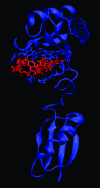The SR protein family
- PMID: 19857271
- PMCID: PMC2784316
- DOI: 10.1186/gb-2009-10-10-242
The SR protein family
Abstract
The processing of pre-mRNAs is a fundamental step required for the expression of most metazoan genes. Members of the family of serine/arginine (SR)-rich proteins are critical components of the machineries carrying out these essential processing events, highlighting their importance in maintaining efficient gene expression. SR proteins are characterized by their ability to interact simultaneously with RNA and other protein components via an RNA recognition motif (RRM) and through a domain rich in arginine and serine residues, the RS domain. Their functional roles in gene expression are surprisingly diverse, ranging from their classical involvement in constitutive and alternative pre-mRNA splicing to various post-splicing activities, including mRNA nuclear export, nonsense-mediated decay, and mRNA translation. These activities point up the importance of SR proteins during the regulation of mRNA metabolism.
Figures






References
Publication types
MeSH terms
Substances
Grants and funding
LinkOut - more resources
Full Text Sources
Research Materials

